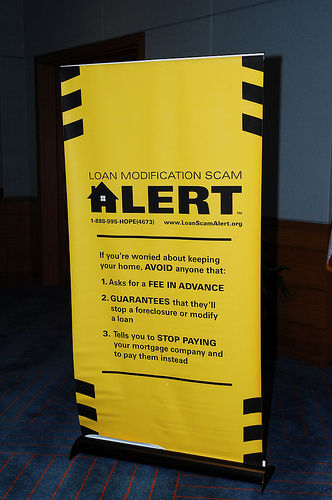Promissory estoppel is a legal argument and cause of action raised when one party makes a promise for which they do not receive any compensation, which the other party relies on in changing their position, such as a promise to modify a mortgage loan. If the promissor had received some consideration, for example ten dollars, then there may be an enforceable contract. However, the promissor in our situation gets nothing in return, but the promise is still enforceable. Sacramento and Yolo business and real estate attorneys argue promissory estoppel as a consideration substitute used when it is required to prevent injustice.
The elements required to show promissory estoppel are (1) a promise, (2) the promisor should reasonably expect the promise to induce action or forbearance on the part of the promisee or a third person, (3) the promise induces action or forbearance by the promisee or a third person (which we refer to as detrimental reliance), and (4) injustice can be avoided only by enforcement of the promise. In a recent California state court decision, lender to a buyer promises involving a trial plan agreement resulted in the court allowing the promissory estoppel claim to proceed.
 In West v. JPMorgan Chase Bank N.A., West was in default on her Washington Mutual loan. In 2009 Washington Mutual told her that she had approved for a trial plan agreement. The approval letter stated: The approval letter stated: “Since you have told us you’re committed to pursuing a stay-in-home option, you have been approved for a Trial Plan Agreement. If you comply with all the terms of this Agreement, we’ll consider a permanent workout solution for your loan once the Trial Plan has been completed.” West made the required trial payments and Chase (which by now had taken over WAMU) confirmed that it had received her request for a permanent loan modification. Chase then denied the loan modification. They said they would provide her with the net present value calculations; she requested them, and said asked for a recalculation using updated information. Chase never provided the calculations. In a conference Chase allegedly promised West that she could resubmit her updated financial data, and that there was no foreclosure sale scheduled. Suddenly the property was sold at a trustee sale.
In West v. JPMorgan Chase Bank N.A., West was in default on her Washington Mutual loan. In 2009 Washington Mutual told her that she had approved for a trial plan agreement. The approval letter stated: The approval letter stated: “Since you have told us you’re committed to pursuing a stay-in-home option, you have been approved for a Trial Plan Agreement. If you comply with all the terms of this Agreement, we’ll consider a permanent workout solution for your loan once the Trial Plan has been completed.” West made the required trial payments and Chase (which by now had taken over WAMU) confirmed that it had received her request for a permanent loan modification. Chase then denied the loan modification. They said they would provide her with the net present value calculations; she requested them, and said asked for a recalculation using updated information. Chase never provided the calculations. In a conference Chase allegedly promised West that she could resubmit her updated financial data, and that there was no foreclosure sale scheduled. Suddenly the property was sold at a trustee sale.
West alleged the following: “Defendant made clear, definite and certain promises to Plaintiff to induce her to enter into oral executed and written HAMP agreements, including promises not to sell during the HAMP reevaluation, that there was no foreclosure date pending, that it would send Plaintiff the NPV input data, that Plaintiff would have 60 days to obtain a reevaluation for a HAMP permanent modification, all of which were false causing Plaintiff to forbear from taking legal action against it, to relinquish mortgage payments (under false pretenses), and incur damages and personal injuries.” Chase argued that there is no definite promise made by the bank.
 The court read the above allegations in context with remainder of the complaint, which had much more detail. It found that West alleged four promises: (1) in the Trial Plan Agreement, Chase Bank promised West that it had offered her a trial loan modification under the HAMP guidelines and, during the trial modification period, Chase Bank would not pursue foreclosure; (2) the April 5, 2010 letter promised West that Chase Bank would reevaluate the denial of a permanent loan modification if she timely submitted evidence the NPV input values used by Chase Bank were inaccurate; (3) on May 24, 2010, a Chase Bank representative promised West she could resubmit her updated financial data for reevaluation for HAMP modification; and (4) on the same day, the Chase Bank representative promised West there was no foreclosure sale date or sale scheduled. These promises were definite enough to pass the test.
The court read the above allegations in context with remainder of the complaint, which had much more detail. It found that West alleged four promises: (1) in the Trial Plan Agreement, Chase Bank promised West that it had offered her a trial loan modification under the HAMP guidelines and, during the trial modification period, Chase Bank would not pursue foreclosure; (2) the April 5, 2010 letter promised West that Chase Bank would reevaluate the denial of a permanent loan modification if she timely submitted evidence the NPV input values used by Chase Bank were inaccurate; (3) on May 24, 2010, a Chase Bank representative promised West she could resubmit her updated financial data for reevaluation for HAMP modification; and (4) on the same day, the Chase Bank representative promised West there was no foreclosure sale date or sale scheduled. These promises were definite enough to pass the test.
Regarding the requirement that West detrimentally relied on the promises, the court again construed the complaint broadly. It found that she alleged that, in reliance on the promises, she did not take legal action to stop the trustee’s sale, or taken other actions including selling her home or finding a co-signer to save her home.
It was fortunate for the lender that the court did not closely parse her cause of action, and was willing to read the entire complaint in context.
Photos: http://tinyurl.com/oe5uww7
http://tinyurl.com/ptbuldf
 California Real Estate Lawyers Blog
California Real Estate Lawyers Blog

